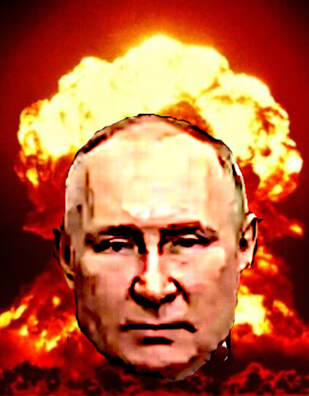
One can interpret Putin’s declaration as a threat of nuclear strikes against any Western country that might militarily intervene against Russia’s invasion of Ukraine. What we don’t know is Putin’s definition of “Western military intervention.” It may be merely providing Ukraine with weapons, which a number of NATO countries—as well as non-member states like Sweden—are doing. Moreover, Russia carried out nuclear exercises in late February.
Russia expert Fiona Hill, formerly the senior director for European and Russian affairs at the National Security Council under Trump, warns that Putin really might use nuclear weapons and that he had tried to warn Trump about his willingness to do so, but Trump didn’t understand the warning. Russia’s recent history of going to extreme lengths—poisonings with radioactive polonium and the Novichok nerve agent are indicators, Hill said, that Putin will stop at nothing to get his way. She also believes that Putin will not stop at Ukraine unless the Western response deters him.
Similar to the United States’ five Defense Readiness Conditions (DEFCONs), Russia has four levels of nuclear alert: 1. CONSTANT. 2. ELEVATED. 3. MILITARY DANGER. 4. FULL. Putin’s high alert translates to level 2, ELEVATED. The Pentagon announced that there has been no change in our nuclear posture, but it never tells the public which DEFCON level applies. Defense experts surmise that, in response to Putin’s move, the U.S. is now at DEFCON 3 (DEFCON 5 is the lowest state of readiness, while DEFCON 1 means nuclear war). We have only declared DEFCON 2 twice (both during the 1962 Cuban Missile Crisis).
The question before us is what would it take for Putin to use nuclear weapons? Would he go to that extreme if his invasion of Ukraine is not going well? Would nukes be on the table if the West’s squeeze of the Russian economy threatens his rule? And if he did deploy nukes—presumably tactical, not strategic weapons—how, if at all, would the U.S. respond? We have only a small tactical nuclear capability remaining in Europe after we decommissioned and removed 98 percent of our European tactical nukes in 1989-91. We likely only have around 100 air-launched tactical, nuclear bombs at six bases in Europe and Turkey. Russia, in contrast, has almost 2,000 tactical nukes in its arsenal. Russia has also updated many of its tactical nuclear weapons, introduced new ones and is improving its delivery capabilities.
In December, Russia’s ally Belarus, allowed Russia to place tactical nuclear weapons within the country. Belarus borders three NATO member nations.
The answer depends to a great extent on Putin’s mental state, something the U.S. intelligence community is deeply worried about. Given the recklessness of his Ukraine aggression, it may not be far-fetched to conclude that the increasingly paranoid and isolated Russian president has “lost it” and gone off the deep end mentally. If that is the case, then we might be uncomfortably close to witnessing the first use of nuclear weapons in 77 years.
Going nuclear is not limited to the employment of atomic weapons. Putin may already be playing the second nuclear card, a dirty bomb. He has captured Chernobyl, site of the worst nuclear disaster ever, and followed that up with nabbing the Zaporizhzhia power station (after recklessly shelling it and starting a fire), home to six nuclear reactors that provide 25 percent of Ukraine’s electricity. Both sites contain massive amounts of highly radioactive material that, if unleashed, could wreak unimaginable devastation. If the Russians cut off Zaporizhzhia’s power, the reactor cores could melt down and spread radioactive fallout across Ukraine and beyond. Europeans, who are most at risk, are stocking up on potassium iodide pills that offer some small protection from radioactive fallout. Given his appalling rocket attack on Zaporizhzhia, the intelligence community’s concern about Putin’s mental state is well-founded.
Russia no longer has a Politburo that, during the Cold War, acted as a counterweight to its supreme leader. In 1953, the Politburo had Secret Police Chief Lavrenty Beria arrested, tried and executed, fearing his ruthlessness and consolidation of power. In 1964, Communist Party Chairman Nikita Khrushchev was ousted by the Politburo for his deviation from the strict Stalinist line, among other things. Today, however, the absence of a Politburo means that there is no potential top-level opposition to Putin. The oligarchs that have supported him likely are not sufficiently organized to stage a coup d’état. Whether the top ranks of the Russian military could or would stage a coup is open to question.
Putin has broken many norms in his two decades in power. Breaking the nuclear taboo is not out of the question. The U.S. and NATO should assume the worst case and prepare accordingly. The risk of a miscalculation by either side is too great to ignore. The time for thinking the unthinkable is now.
Richard Hermann
March 5, 2022


 RSS Feed
RSS Feed